Project Overview
The product:
BookWorm Haven fosters a sense of community among readers, highlighting the pleasures of reading while also serving as a platform for literary exploration. The app enables connections among book aficionados, facilitating mutual learning and offering a space to appreciate the written word. Moreover, users can share their insights effectively by composing and submitting reviews of the books they have experienced, contributing to a rich tapestry of literary discussions.
Project Duration:
April 2023 - Present (Ongoing)
The Challenge:
The challenge for this project revolved around devising a user flow that seamlessly allowed users to select books they had read and compose reviews for each. The focus was on creating an intuitive pathway that smoothly guided users through book selection and effortlessly transitioned them to the review creation stage.
My Role
UX Design, User Research, Information Architecture, Usability Testing, Prototyping and Wireframing.
The Goal:
The goal was to optimize the user flow for book selection and review composition by creating a frictionless experience for end users. The aim was to enhance user engagement, simplify the process of sharing past reading experiences, and elevate overall user satisfaction by designing and developing an intuitive and coherent flow.
Responsibilities:
Conducting thorough user research to inform design decisions, implementing logical and user-friendly content organization, executing usability tests, gathering feedback to validate design solutions for seamless and intuitive user experience, and creating interactive prototypes and wireframes for effective communication and iterative design refinement.
Starting The Design: Digital Wireframes
Setting a First Impression
The user's journey began on the app's homepage, where the design's initial iteration facilitated an immediate understanding of BookWorm Haven's offerings. Users were presented with the option to delve deeper into the app's functionalities and access an array of in-app features.
This approach not only streamlined user navigation but also efficiently introduced users to the diverse range of tools and experiences that BookWorm Haven had to offer.
Insightful Title Selection
The initial BookWorm design carved out a space for users to explore books elevated by peer reviews. Titles were selectable, offering access to others' insights and enabling users to contribute their perspectives. This strategy aimed to amplify engagement and nurture a thriving reading community.
Interactive Rating Experience
Upon selecting a title, users were guided to the 'About the Book' screen. This interface provided a succinct summary of the title, an array of user reviews, and a platform for users to share their own personal feedback on the title. Users could also engage by rating reviews using intuitive thumbs-up or thumbs-down options. This design enhanced user involvement, facilitated informed decisions, and promoted community engagement.
Streamlined Review Interaction
Upon selecting "Review this Title," users transition to the review page. The page showcases a book cover photo, title, and author. A user-centric text box awaits, encouraging insightful reviews. This design offered a visual reference, easy-to-use input, and personalized engagement, fostering valuable user-generated content.
Understanding The User : User Research
User Research: Summary
Twelve users were recruited via LinkedIn and personal contacts to participate in the research. Participants selected based on having previous experiences using Goodreads, LibraryThing, Wattpad, Litsy, and other apps and/or websites whose overall goal is to foster a sense of community engagement among book enthusiasts.
User Research: Pain Points
User research has highlighted key pain points encountered by previous users of similar apps and websites. These issues included challenges in effectively navigating and engaging in discussions, potential disappointment due to limited book variety and recommendations, complexities in submitting reviews, missed opportunities for author interaction, unsatisfactory personalization features, and technical glitches during virtual book club sessions.
User Personas
User personas were created by conducting in-depth user research, which included interviews and surveys. The data was analyzed to identify different user types with similar experiences, needs, and goals. The personas were validated with stakeholders to ensure that they were accurate and representative of the target audience. The personas were then used to guide decision-making throughout the design process.
Jamal C.
Age: 45
Location: Chicago, Illinois
Educational Background: Associate's degree in Business Administration
Occupation: Small Business Owner
Background
Jamal is a dedicated boutique bookstore owner. He's been a lifelong book lover and believes in the power of literature to enrich lives. He enjoys connecting with his local community through book-related events and discussions.
Goals
Jamal aims to discover an online platform that complements his efforts as a bookstore owner. He seeks a space where he can engage with readers, share his insights, and recommend books from his store's collection, enhancing his store's sense of community.
Frustrations
Jamal often faces challenges in finding digital avenues that facilitate meaningful connections with readers. He's frustrated by platforms that prioritize quantity over quality and miss the essence of personal and local book communities.
Motivations
Jamal is motivated by the prospect of finding a platform that aligns with his commitment to fostering book communities and looks forward to extending his store's presence, engaging with readers beyond his physical location, and contributing his expertise to enrich the literary dialogue.
Daniel R.
Age: 19
Location: Seattle, Washington
Educational Background: High School Graduate
Occupation: Student and Part-Time Retail Associate
Background
Daniel is a student and Retail Associate. He has a growing interest in books beyond his academic requirements and aims to find a platform that introduces him to new reading experiences and allows him to connect with others who share his newfound passion.
Goals
Daniel's goal is to discover an online haven where he can explore books outside of his school curriculum. He seeks a space that not only provides book recommendations but also connects him with fellow readers who can guide him in his literary journey.
Frustrations
Daniel often struggles with locating platforms that cater to his entry-level interest in books. He's frustrated by platforms that assume a higher level of prior knowledge and engagement, making it difficult for newcomers like him to engage meaningfully.
Motivations
Daniel is motivated by the opportunity to join any platform that welcomes readers of all levels and backgrounds. He looks forward to connecting with others who can introduce him to diverse literary worlds, recommend accessible titles, and accompany him on his reading adventure.
Usability Study
Usability Study: Objective
The objective of the usability study was to assess how easily users were able to navigate and interact with the first iteration of the BookWorm Haven mobile app. User interactions with the prototype were observed and analyzed to identify pain points and areas for improvement.
Usability Study: Methodology
The usability study employed remote usability testing sessions to evaluate the overall user experience of the prototype's first iteration. A group of twelve participants were recruited via Linkedin and Dscout, and were selected based on their prior experiences in using websites or mobile apps similar to BookWorm Haven to learn more about, view, and leave reviews for their favorite book titles.
Testing sessions were moderated by members of the research team. Participants were tasked with using the first iteration of the BookWorm prototype to learn more about, view, and to leave reviews for a selected book title. Participants' interactions with the first iteration of the prototype were observed, allowing for the identification of usability issues and insights into user behavior. The methodology aimed to gather comprehensive feedback to inform the iterative design process.
Usability Study: Findings
Usability study findings revealed notable pain points in the overall user experience. Users expressed frustration due to the absence of a search function for seamless book discovery,and were concerned about the insufficient display of book covers, resulting in difficulty understanding book details.
Furthermore, users highlighted challenges with cramped text boxes for review writing, indicating the need for more spacious and expandable input field designs. These insights emphasized the importance of user-centric improvements to enhance the overall app experience.
Affinity Mapping
The affinity map organized user insights into categories, revealing patterns and pain points. This visual representation aided in deriving design solutions from past user feedback.
Affinity Map Insights
The Affinity Mapping session yielded valuable insights into user experience challenges. Participants expressed frustration over the absence of a search function for efficient book discovery and struggled to locate desired titles promptly or narrow down choices effectively.
Additionally, users encountered issues with book cover clarity and size, hampering their understanding of book details. Similarly, writing reviews posed challenges due to limited and non-expandable text boxes, leading to frustration when exceeding limits and difficulty expressing thoughts within confined spaces.
Discovery Enhancement
The Affinity Map revealed user concerns, including how the lack of a search function led to challenges in swiftly locating desired books and narrowing down choices effectively. Addressing these insights would enhance the app's discovery process, streamline book selection and optimize user engagement.
Cover Display Challenges
The Affinity Map highlighted concerns about book cover display. Users noted inadequate size and visual appeal, which hindered their understanding of book details.
Review Input Challenge
The Affinity Map highlighted user frustrations with review text boxes. Participants encountered difficulties when reviews exceeded limits or due to constrained space for expressing thoughts.
User Journey Map
The user journey map was created using insights from the initial usability study. The map visualizes user interactions, emotions, pain points, and enhances understanding. Its results aided the design team in identifying areas for improvement, streamlining the user experience, and ultimately leading to a more user-centered design
Refining The Design
Addressing User Pain Points
Simplified Search Interface
Pain Point: Lack of a search function to easily find a specific book.
Design Solution: Adding a search bar at the top of the home screen to allow users to search for a specific book.
Enhancing Cover Visibility
Pain point: Book covers were not displayed clearly or in a large enough size.
Design Solution: Showcase book covers prominently and allow for zoom-in capability if possible.
Streamlined Review Input
Pain Point: Text box for writing the review is too small and not easily expandable.
Design Solution: Make the text box expandable to allow for easy editing.
Mockups
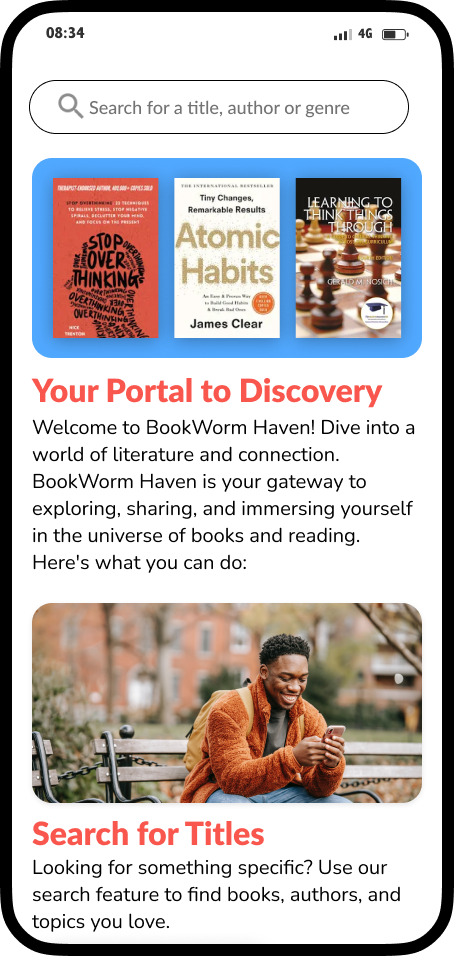
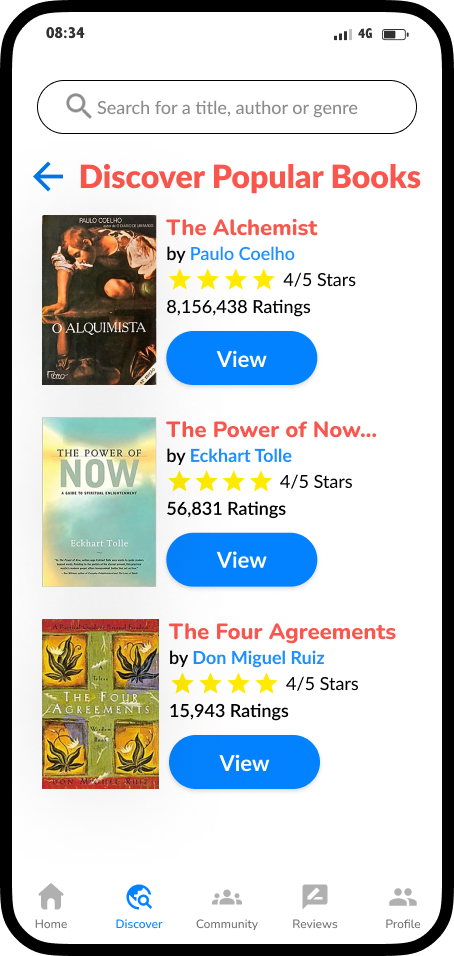
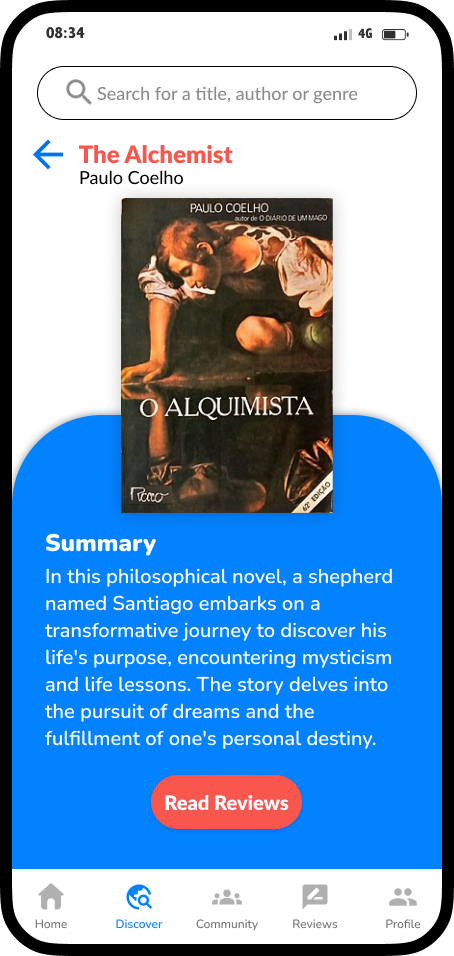
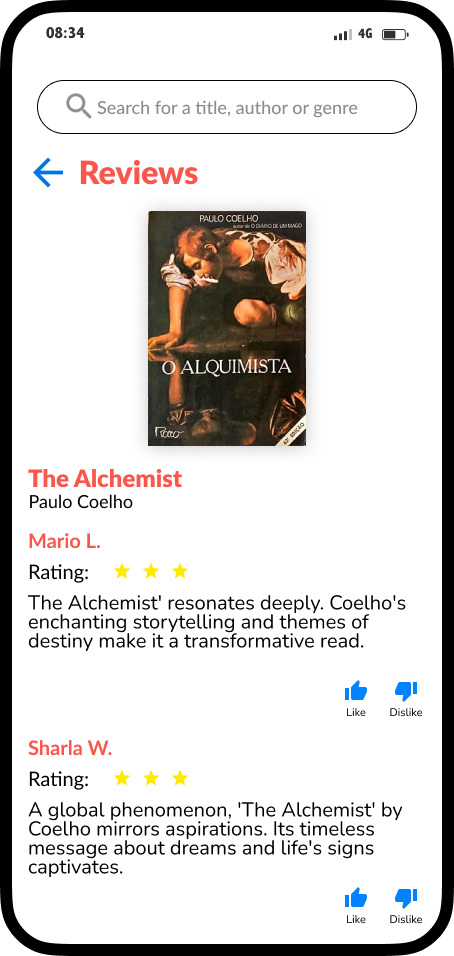
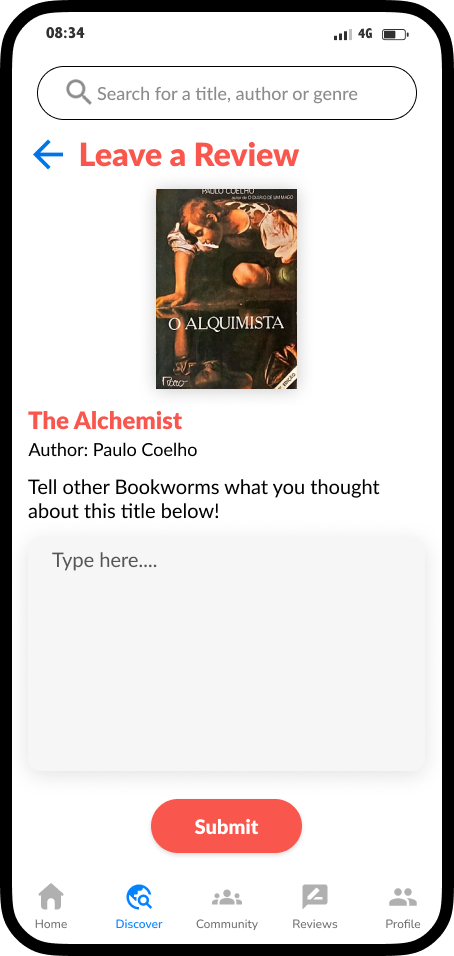
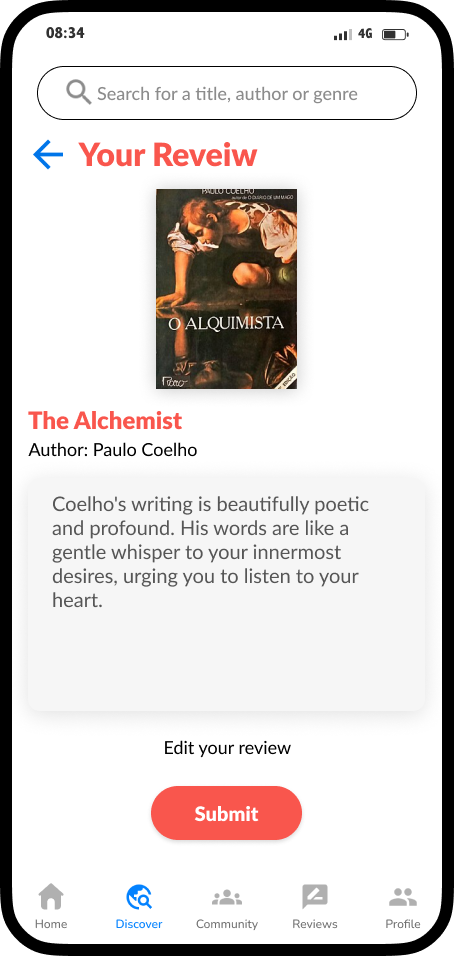
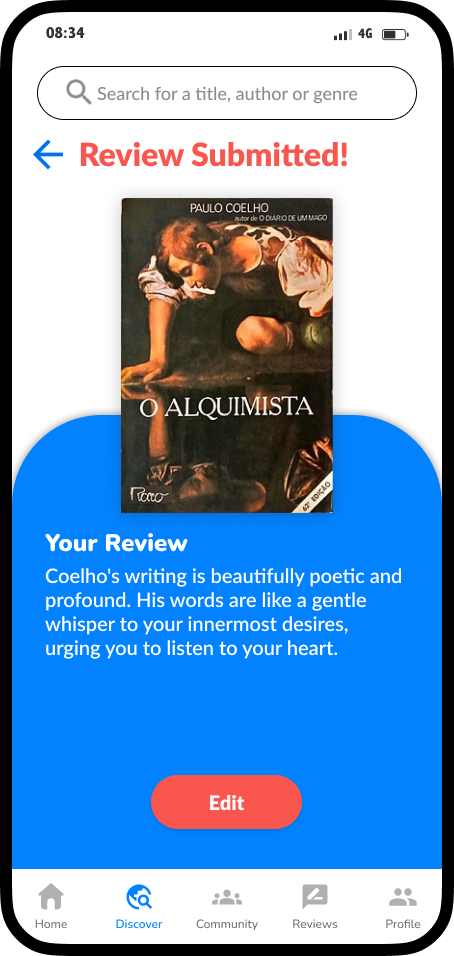
High-Fidelity Prototype
Usability-Driven Prototype Design
Utilizing insights from the usability study and affinity mapping session, the high-fidelity prototype embodies a user-centric approach that seeks to address the usability issues gained as a result of analyzing the insights from the user research and pain points from the first round of usability studies.
Accessibility Considerations
Text-to-Speech Compatibility
Provide compatibility with text-to-speech software to allow users with reading difficulties or visual impairments to listen to the content.
Contrast Testing
Perform contrast testing to confirm that all text and graphical elements meet the necessary contrast ratios for readability.
Interactive Feedback
Provide clear and instant feedback when users interact with buttons or elements to enhance the user experience.
Next Steps
Continued Usability Testing
Identify overlooked issues, validate improvements, and enhance user experience based on fresh insights from real users.
Improve UI
Elevate UI to enhance user interactions, simplify navigation, and cultivate favorable experiences by providing users with a design that offers a seamless interactive design, intuitive navigation, and user-centered aesthetics.
Design for Fingers
Ensure touch targets are appropriately sized and spaced for easy interaction on mobile devices to enhance user experience by reducing accidental taps and improving accuracy.
Takeaways
Impact
BookWorm Haven creates a nurturing environment for readers by fostering engagement through intuitive navigation, promoting literary discussions and by providing a seamless platform for exploration. The app has the potential to elevate user satisfaction by transforming the act of reading into an interactive, immersive, and shared experience for all users.
What I Learned
During the process of designing the app, I gained valuable insights into user behavior and preferences. Conducting user research and usability testing revealed patterns in user interactions, helping me refine the app's design and information architecture for intuitive navigation.















